Taking the Leap with Red Bull Cliff Diving: Extreme Sports Edition
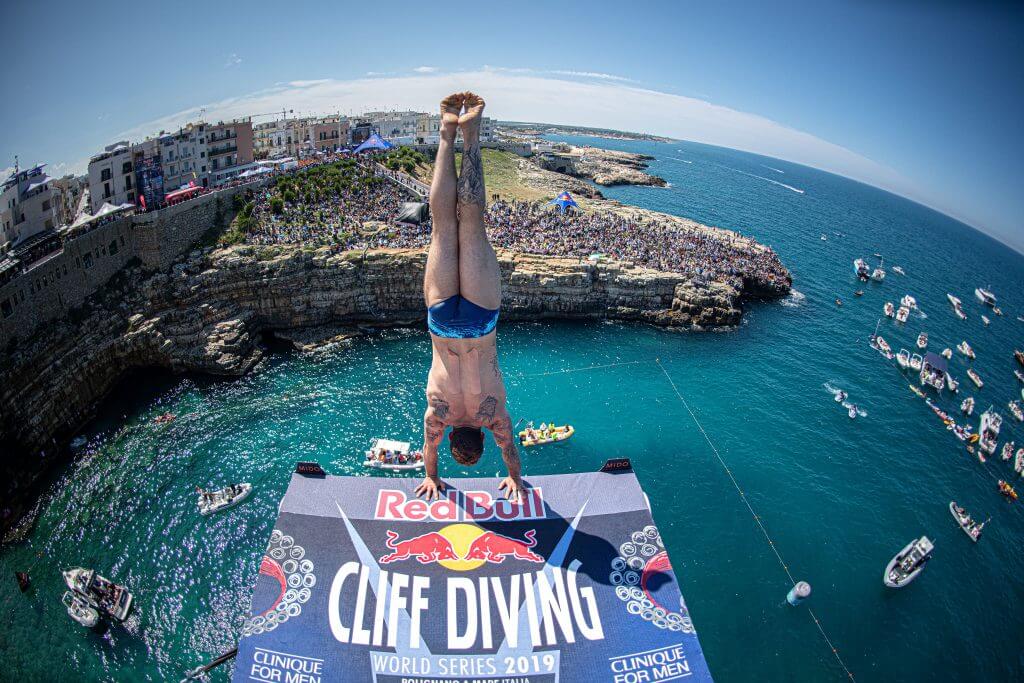
By Madeline Ladd, Swimming World Intern.
Few sports perfectly integrate both mind and body in quite the way that cliff diving does. This sport, which happens to be the oldest extreme sport in the world, is not for the faint of heart. Dives from up to 90 feet high with multiple twists and somersaults prove these athletes have fearless spirits and outstanding athleticism. Cliff diving events, such as the Red Bull Cliff Diving World Series, are held all around the world and showcase the most daring of athletes.
Preparation and Organization

Photo Courtesy: Romina Amato/Red Bull Content Pool
Several private organizers host cliff diving events in both small and large scale formats. Cliff diving events are held at the highest level by FINA, who included high diving as a professional sport in 2012. The High Diving World Cup, High Diving World Championships and Red Bull Cliff Diving World Series are some of the elite-level high diving competitions.
Introduced in 2009, The Red Bull Cliff Diving World Series is an international series of cliff diving events in which the best-of-the-best come to compete for the coveted spot of Cliff Diving World Series Champion. The World Series stops at seven locations around the globe, with this year’s stops ranging from the Philippines all the way to Spain. Check out the full list by clicking here.
When it comes to the logistics of an event as well as the preparation that goes into a competition itself, Red Bull Cliff Diving competition director Hassan Mouti knows the ins-and-outs.
“With a fixed set of rules for the athletes to get prepared for, the Red Bull Cliff Diving World Series has been providing a platform for high class competition from great heights. Introduced in 2009 with 12 male athletes, the World Series has featured 56 men and 22 women up until now with a lot of free talent pushing into the Series. At each stop, up to four wildcards (men and women) get the chance to prove their talent. The current age range is from 16 (Aidan Heslop, GBR) to 44 (Orlando Duque, COL). The youngest ever female diver is Maria Paula Quintero from Colombia, who finished in second place in the competition in Italy earlier this month.” -Hassan Mouti
Much preparation goes into first finding a venue for the event(s). The next hurdle is ensuring that all regulations are met in terms of water depth, safety, travel logistics and platform construction. When it comes to choosing the location, the committee receives suggestions from athletes, the Red Bull offices in potential host countries, tourism boards and even fans. Some areas where cliff diving is famous, such as Acapulco in Mexico, as well as the birthplace of cliff diving – Hawaii – are not safety regulated and therefore cannot be used as venues. “However, over the last 10 years, the Red Bull Cliff Diving World Series was able to find venues that the athletes call ‘made for cliff diving,’ like the Portuguese Azores,” Mouti states. “We just had a competition with dives straight from the rocks as well as man-made platforms high above the Atlantic Ocean.”
The multiple venues across the globe give athletes a chance to travel and explore their unique surroundings. Mouti explains, “What all venues of the World Series have in common is the uniqueness. Remote or urban, historically relevant or super pure, off the rocks or from outstanding landmarks: in combination these locations make for a diversified calendar for both athletes and spectators.”
Showcasing the Athlete
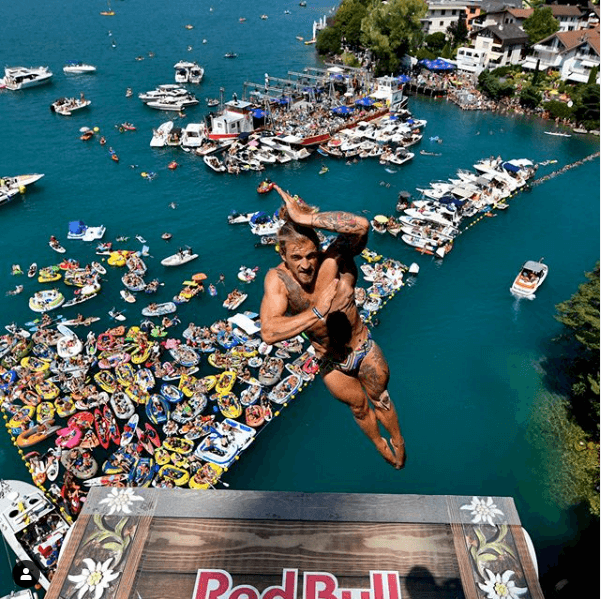
Photo Courtesy: Romina Amato/Red Bull Content Pool
It would not be appropriate to talk about cliff diving without mentioning the men and women who call it their sport. Though it may superficially resemble Olympic diving, cliff diving is an entirely different beast.
“Diving from great heights demands a special mindset, as England’s Blake Aldridge once put it when he changed from Olympic to cliff diving. A good 10m diver is not automatically a good cliff diver. The mental part is crucial in this sport and not everybody is made for it.” -Hassan Mouti
Mental preparation is key when it comes to cliff diving. Athletes visualize their dives hundreds of times, and many have said they felt like they have done the dive before actually stepping onto the board. However, physical fitness also plays a crucial role in performance. Training from 27m on a permanent basis is only possible in two locations around the world: in Austria’s Area 47 and in China’s Zhaoqing Yingxiong High Diving Training Center. There are other training facilities in the works for the future, such as one in Fort Lauderdale at the Hall of Fame Aquatic Center. Since these resources are not easily accessible to all athletes, many adjust their training to fit their schedules and locations.
“In general, the dives are broken down into three parts – take off, flight and entry – and trained from a regular 10m platform. That’s also how news dives are learned; when the divers have the chance to dive from 21/27m and feel ready for it, they put these three parts together.” -Hassan Mouti
Eleanor Townsend Smart & Andy Jones
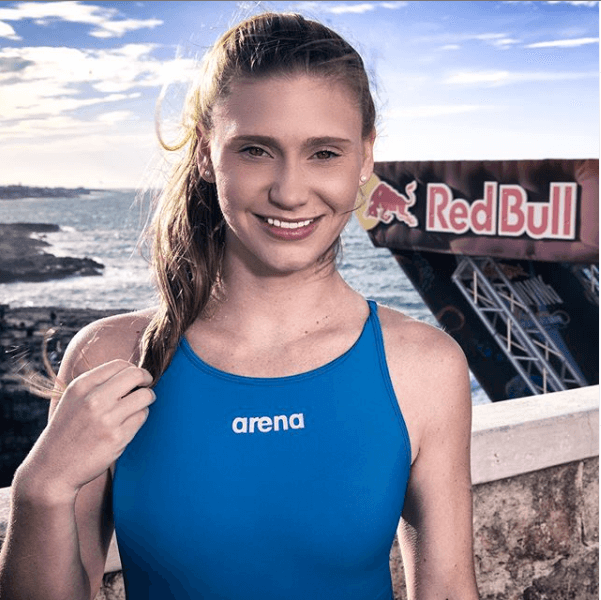
Photo Courtesy: Red Bull, @ellietsmart Instagram
America’s best this season, Eleanor Townsend Smart and Andy Jones, are two prime examples of fearless athletes immersed in the sport of cliff diving.
Ellie Smart (@ellietsmart) is a professional high diver and is currently the youngest high diver representing the United States at the age of 23. She is the bronze medal winner from the 2018 FINA World Cup. Now, she is a permanent diver in the 2019 Red Bull Cliff Diving World Series. In addition to diving professionally, Smart also runs the Clean Cliffs Project. This organization helps to prevent plastic pollution in bodies of water around the world. She inspires others to take action through the art of cliff diving. “The Clean Cliffs Project started with a simple idea: let’s keep doing what we love while leaving a positive impact on the environment,” Smart says.
Find out more about The Clean Cliffs Project through social media @cleancliffsproject or at www.cleancliffsproject.org.
Andy Jones (@andy.jones.diver), 34, is a California-based diver who won the Red Bull Cliff Diving World Series in Dubai in 2016. He ended up placing third overall that same year. Over the years, Jones has earned his fair share of spots on the podium, despite not coming from a classic diving background. He has spent his life involved in other aerial sports, including the renowned Cirque du Soleil show. With the help of his diving friends, Jones combined his love for film and diving by creating USA Cliff Diving’s website and Youtube channel in hopes of bringing increased awareness to the sport. Through documenting his experiences, he’s able to give others insight to what the life of a diver is truly like. In addition, Jones also acts as a professional stuntman in big film productions in LA.
Smart and Jones enlightened Swimming World by answering several questions related to their experiences as cliff divers.
How did you get into cliff diving?
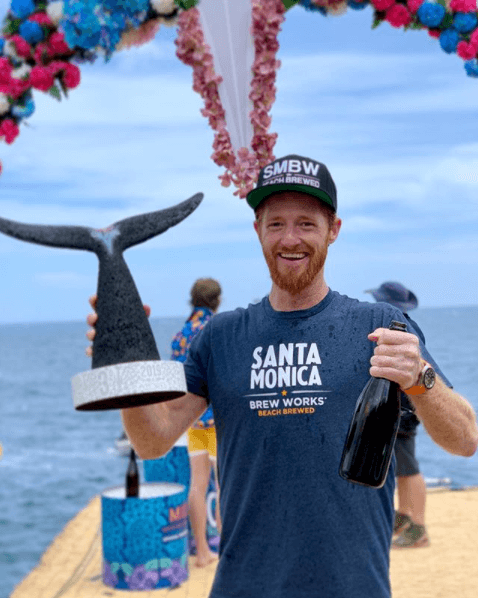
Photo Courtesy: Red Bull, @andy.jones.diver Instagram
Smart: My “normal” diving career began at the age of five when I competed in my first diving meet. I instantly fell in love with the sport and set my sights on competing internationally. Then at the age of fifteen, I packed my bags, kissed my family goodbye, and moved away from home to train in Texas in hopes of making my dream a reality. After high school, I was given the opportunity to dive collegiately at the University of California, Berkeley.
Once my college career was over, I never thought I would set foot on a diving tower again… and then my best friend, Anne, invited me to go cliff jumping with her. At first I was reluctant, but she eventually convinced me to go with her. It ended up being the best decision of my life! I realized that everything up to that point in my life had been preparing me for this! After that first jump, I set my sights on joining the Red Bull Cliff Diving tour and representing the USA in FINA competitions!
Jones: I was always jumping off cliffs as a kid with my brothers. Not just into lakes – we were jumping off cliffs on our skis up in the mountains as well. When I graduated from the University of Utah, I started doing diving shows. That quickly led to high diving and Russian swing in Cirque du Soleil. After a few years, I decided to give Red Bull a try.
How many hours per week and months per year do you train?
Smart: In total, I train about 15 to 20 hours per week. I train in the pool three to five times a week and in the gym three to four times a week. However, I am also the Graduate Assistant Diving Coach at the University of Minnesota and doing my master’s in sport psychology, so I’m constantly around the sport!
Jones: A few years ago, I was training a lot more than I do now. It used to be about 12 hours a week. Now it’s more like two.
Where and how do you go about training?
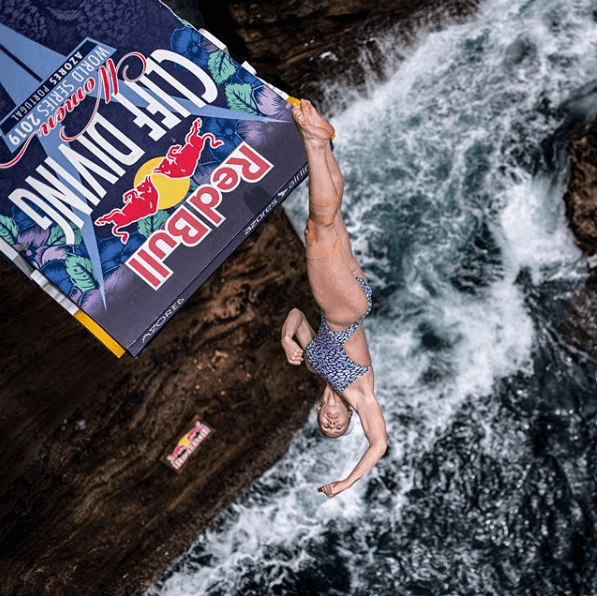
Photo Courtesy: Red Bull, @ellietsmart Instagram
Smart: I train at the University of Minnesota. My training is very similar to that of a “normal” diver. The main difference is that I train entries to my feet opposed to my head! Basically, we break our dives into two parts. The first part is the first half of our dive, which looks similar to a dive you typically see in the pool. Then we practice the second half of our dives, which is the feet-first entry. Since there are very limited places with a 20-meter platform, we usually just show up to a competition and put the two parts together to make our dive.
Jones: When I have time, I go train from 10-meter at Rose Bowl or USC. It will be July in a few days, and I’ve been once since last July.
On average, how many competitions do you participate in per year?
Smart: It really depends on the year. This year is my first year as a permanent diver on the Red Bull Cliff Diving World Series, which means I get to compete in every competition! We have seven stops this season. We also have two FINA competitions and a few independent competitions. Total, I will compete in 12 events.
Jones: I’d say I compete in 10 to 12 competitions every year.
What is one specific memory from your cliff diving experience that stands out?
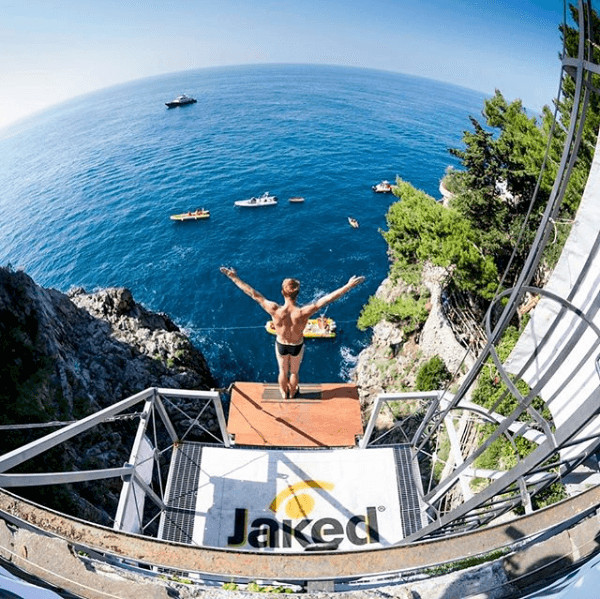
Photo Courtesy: Andy Jones, @andy.jones.diver Instagram
Smart: My favorite memory was at the 2018 FINA World Cup. I had a terrible season leading up to the event and was feeling extremely discouraged. Something just clicked in me, and I was able to put everything aside and just dive. Each dive was better than the last, and I ended up winning a bronze medal! To win an international medal for my country was an absolute dream come true. I have dreamt of that say since I was a little girl!
Jones: Lots. But one that comes to mind is when we were competing in the first and only every night event in Dubai. I was in first place, and the 6-time world champ was diving right before me. He missed his last dive a bit, and I looked at our sports director Niki Stajkovic and got chills. We both knew I had a chance at winning. I composed myself nailed my dive and won the event.
What is your favorite part about cliff diving?
Smart: There are so many things I love about cliff diving! I’d have to say my favorite part is getting to travel around the world and experience so many new places. Without the sport, I would never be able to see so much of the world. It is such a blessing every day.
Jones: When you’re standing at the top of a 100-foot cliff and you have the ability to jump from it and not get hurt. It is a freedom that not everyone gets to experience.
What is one message you would want to give about cliff diving to people who do not know much about it?
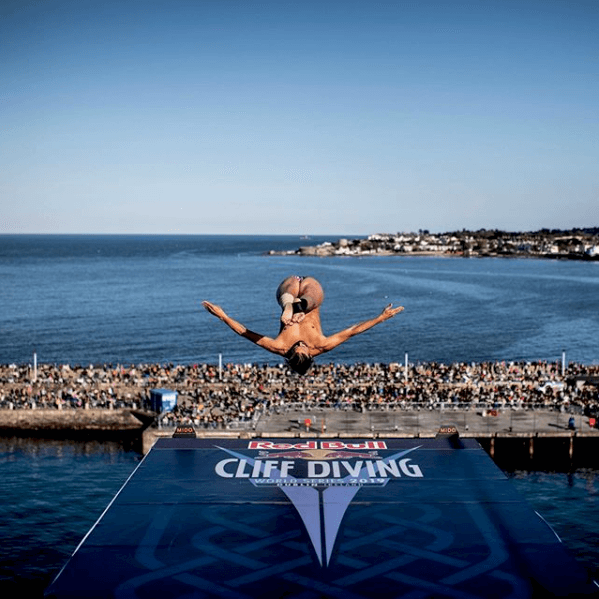
Photo Courtesy: Romina Amato/Red Bull Content Pool
Smart: I think the most important thing for people to know is that we are professionals and have trained thousands of hours to be able to do what we do. Many people think it’s very dangerous and we’re a bunch of daredevils. The truth is, it’s no more dangerous than other professional athletes competing in their sport. Every sport has its risks and dangers, but we prepare for that the best we can.
Jones: We’re not just dare devils hucking ourselves. We have trained most of our lives to be able to do what we do, and the risks are more calculated than people might assume. That’s not to say some of us don’t have a screw loose.
All in all, cliff diving takes intense physical and mental preparation and truly is a sport like no other. Athletes spend years training both technically and mentally to take a leap that many of us would never dare to attempt.
“Cliff diving gets as close to flying as one can possibly ever get without any additional machinery,” states Mouti. “It’s pure, it’s exciting and jaw-dropping when these great athletes propel themselves from dizzying heights in the most acrobatic and elegant way!”
Check out Red Bull Cliff Diving on Social Media: @redbullcliffdiving
-All commentaries are the opinion of the author and do not necessarily reflect the views of Swimming World Magazine nor its staff.




yes! it takes years of practice and hard work to achieve all that!